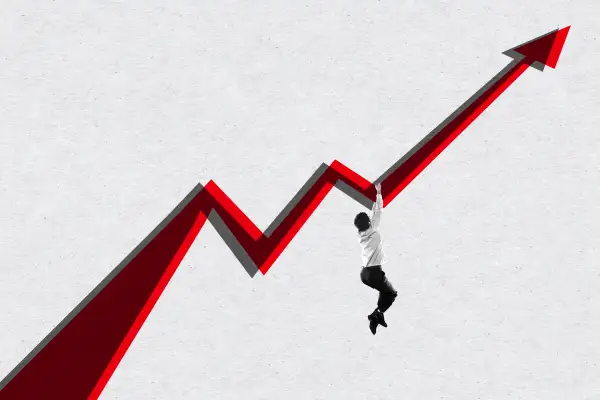The Sneaky Way Inflation Can Cause You to Pay Higher Taxes

If you’re making more money this year, congrats! But how much is it really worth? Thanks to unusually high inflation, the prices of everything from groceries to pet food have increased. So while there may be more money in your pocket, it's possible you can buy less.
If that’s not enough to give you goosebumps this Halloween season, here comes “bracket creep.” This phenomenon occurs when rising income pushes you into a higher tax bracket, but inflation decreases your purchasing power.
Basically, Uncle Sam sees you’re making more, and taxes you accordingly — even though your higher earnings are not actually worth more. It’s a real case of more money, more problems.
Why high inflation could mean higher taxes
At the federal level, the IRS annually adjusts tax brackets to changes in the costs of living. In other words, the agency crunches the numbers so you get taxed at a presumably fair rate, based on the real value of your earnings.
The problem is the adjustment doesn’t always go far enough. Inflation currently stands at around 5% over the last 12 months. But federal bracket limits increased between only 0.71% to 1.0% from 2020 to 2021, on average.
Bracket creep can hit taxpayers another way when states do little or nothing to adjust tax brackets for inflation. A recent study by the Tax Foundation shows that 15 states and Washington, D.C., don’t adjust their tax brackets for inflation at all, and 13 states "don’t index any relevant major component” of their tax codes.
For example, some states don't adjust the standard deduction to inflation. This means inflation can reduce the real value of this deduction. Here are the 13 states that don't make any significant inflation-protection adjustments to their tax system:
- Alabama
- Connecticut
- Delaware
- Georgia
- Hawaii
- Kansas
- Louisiana
- Mississippi
- New Jersey
- New York
- Oklahoma
- Virginia
- West Virginia
For an idea of how this concept plays out in reality, imagine you’re a Delaware resident and your income jumped from $60,000 in 2019 to $64,000 in 2020. According to the Tax Foundation study, your income for 2020 would have “about the same purchasing power” as it did in 2019.
The problem is that Delaware doesn’t index income tax brackets to inflation. The marginal rate was 5.5% on income between $25,000 and $60,000 in both years. And the extra $4,000 in 2020 income is taxed at the higher rate of 6.6%. That means you end up paying $264 more in state taxes even though the real value of your money stayed the same.
How can you protect yourself from inflation?
Simple math means that you need more money to offset the impact of inflation. So it's important to know your worth, and talk to your employer and negotiate a higher salary that meets or beats inflation. Right now, while there's a labor shortage and employers are willing to pay higher salaries and big bonuses to find good workers, may be the best time to do it.
“Since many industries are experiencing a labor shortage, workers are in a better position to negotiate salaries,” says Alvin Carlos, a certified financial planner and managing partner at District Capital Management.
How high should you go when asking for a bigger salary? To beat current inflation, you should aim for a raise of 5% or higher.
Also, stick to your long-term investing strategy. In the past century, the stock market's average annual return before inflation has been about 10%.
“Not a lot of people think about stocks as a good inflation hedge,” Carlos says. “But if you look at the data from the last high inflationary period that we had in the '80s, stocks actually matched the inflation rate.”
Carlos writes in his newsletter that “during the high inflationary period of 1966 to 1982, the S&P 500 stocks returned 6.8% annualized, matching the rate of inflation.”
But remember to not keep your eggs in one basket. A diversified portfolio should include a healthy mix of stocks, bonds, cash and alternative assets. You can work with a financial advisor to come up with a personalized strategy. Or consider a robo-advisor, which can build an automated diversified portfolio based on your personal situation.
You can also invest more in a 401(k) or individual retirement account (IRA). Every dollar you sock away lowers your taxable income and grows your nest egg. Win-win. Here are some key details.
Retirement plan: 401(k)
- Contribution limit: $19,500 ($26,500 if age 50 or over)
- Contribution deadline: Dec. 31, 2021
Retirement plan: IRA
- Contribution limit: $6,000 ($7,000 if age 50 or older)
- Contribution deadline: May 17, 2021
Keep in mind that the IRS adjusts 401(k) and IRA contribution limits every year, so these numbers could change when you file taxes in 2022.
Another way to beat bracket creep and potential higher tax burdens is through smart tax planning. Work with a tax professional or use the latest tax software to secure all the deductions, credits and exemptions you can.
And if you’re still panicking about raging inflation, remember it should be temporary. All bad things must come to an end too.
More from Money:
Here's Why You Should Ask for a 5% Raise Right Now
How to Inflation-Proof Your Retirement as Prices Continue to Rise

